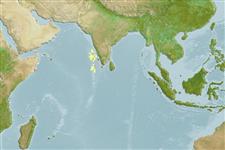Elasmobranchii (haaien en roggen) (sharks and rays) >
Torpediniformes (Electric rays) >
Narcinidae (Numbfishes)
Etymology: Benthobatis: Greek, benthos = depth of the sea + Greek, batis, -idos = a ray (Raja sp.) (Ref. 45335); moresbyi: Named for Capt. Moresby of the Indian Navy..
More on author: Alcock.
Environment: milieu / climate zone / depth range / distribution range
Ecologie
marien bathydemersaal; diepte 787 - 1071 m (Ref. 48493). Deep-water; 15°N - 5°N, 49°E - 77°E (Ref. 114953)
Indian Ocean: Arabian and Laccadive seas (off Travancore coast), Yemen and Somalia; including India (Ref. 118627).
Grootte / Gewicht / Leeftijd
Maturity: Lm ? range ? - ? cm
Max length : 35.1 cm TL mannelijk / geslacht onbekend; (Ref. 48493); 39.2 cm TL (female)
Korte beschrijving
Morfologie | Morfometrie
Dark brown dorsal and ventral surfaces; ventral entirely dark. Snout elongated, usually more than 1/3 in disc length (preocular snout region 40% in disc length in lectotype). Disc oval, longer than wide. Dorsal fins with long, fleshy bases which are much longer than height of the fin (dorsal fin length 50-55% of fin height). Origin of first dorsal well anterior to posterior tip of pelvic fins, close to mid pelvic length; dorsal fins close together, interdorsal space less than length of dorsal bases. Distance between second dorsal and caudal fins much smaller than length of base of second dorsal fin. Caudal fin extremely elongated, reaching almost 1/2 tail length as measured from posterior tips of pelvic fins; caudal fin length 40.4% of distance between cloaca and caudal fin tip (Ref. 48493).
A benthic species on continental slope. Probably suction feeds on bottom-dwelling invertebrates based on its oral morphology. Biology little known. Maturity size uncertain, probably close to 18 cm TL in males (Ref. 114953).
Levenscyclus en paargedrag
Maturiteit | Voortplanting | Paaien | Eieren | Fecunditeit | Larven
de Carvalho, M.R., 1999. A synopsis of the deep-sea genus Benthobatis Alcock, with a redescription of the type species Benthobatis moresbyi Alcock, 1898 (Chondrichthyes, Torpediniformes, Narcinidae). p. 231-255. In Séret B. & J.-Y. Sire [eds]. Proc. 5th Indo-Pac. Fish Conf., Noumea, 1997. (Ref. 48493)
Status op de Rode Lijst van het IUCN (Ref. 130435)
Gevaar voor de mens
Harmless
Gebruik door de mens
Meer informatie
Leeftijd/GrootteGroeiLengte-gewichtLengte-lengteLengtefrequentiesMorfometrieMorfologieLarvenLarvale populatiedynamiekRekruteringAbundantieBRUVS
ReferentiesAquacultuurAquacultuurprofielKweeklijnenGeneticaElectrophoresesErfelijkheidZiektesVerwerkingNutrientsMassaconversie
Tools
Speciale rapporten
Download XML
Internetbronnen
Estimates based on models
Preferred temperature (Ref.
123201): 2.7 - 6.7, mean 6.3 °C (based on 5 cells).
Fylogenetische diversiteitsindex (Ref.
82804): PD
50 = 0.5625 [Uniqueness, from 0.5 = low to 2.0 = high].
Bayesian length-weight: a=0.01175 (0.00476 - 0.02897), b=2.88 (2.66 - 3.10), in cm total length, based on LWR estimates for this (Sub)family-body shape (Ref.
93245).
Trofisch niveau (Ref.
69278): 3.3 ±0.4 se; based on size and trophs of closest relatives
Weerstandsvermogen (Ref.
120179): laag, minimale populatieverdubbelingstijd 4,5-14 jaar (Assuming fecundity<100).
Fishing Vulnerability (Ref.
59153): Low to moderate vulnerability (29 of 100).
